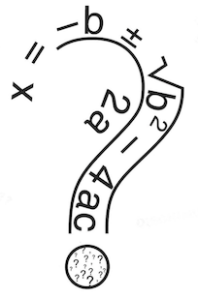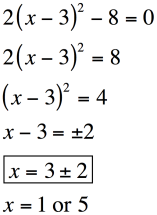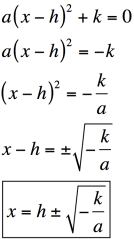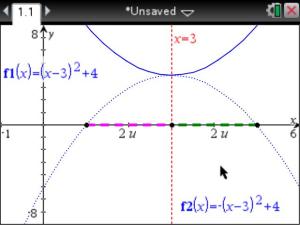
I love the quadratic formula – what self-respecting math geek wouldn’t? I would always wear my best suit on the day of the quadratic formula lesson. Somehow, my students didn’t seem to share in the joy the same way I did. Adding a “Pop Goes the Weasel” song raised the joy-level a wee bit, but my goal of mathematical joy was nowhere to be seen.
One of the lessons I shared at my “Different Approaches to Familiar Topics” workshop aims to change that – if not more joyous, at least let’s make solving quadratic equations using a formula more meaningful.
Getting Started
Here’s the student handout (QuadraticEquations). It begins with activating prior knowledge – solving a quadratic equation by graphing, and algebraically (non-formula). More importantly, there is a connection between the graphical and algebraic solutions.
Here’s the equation, with an algebraic solution:
Wait a minute, why the box around the penultimate step, instead of the answer? Because the answer doesn’t tell the whole story, the box step says so much more. Consider the graphical solution:
 See the connection? Don’t tell students the connection – they will find it (hence the question prompt in the handout). Yes, the zeros are symmetric about the axis of symmetry – obvious to us math geeks, but why should we have all the fun?
See the connection? Don’t tell students the connection – they will find it (hence the question prompt in the handout). Yes, the zeros are symmetric about the axis of symmetry – obvious to us math geeks, but why should we have all the fun?
Generalizing
On to page 2. It’s time to generalize. Once again, don’t do this for the students – they can do it themselves; and then they can do the sense-making.
Alrighty then, a new formula, but one that makes sense. A prompt for students, and for you: Explain and illustrate the meaning of this formula in terms of the graph of a quadratic function.
Let’s not underestimate the power of connections. The formula connects symbolic meaning to graphical meaning. Sure, there’s some meaning with the traditional formula, but how many make sense of the axis of symmetry being ![]() , let alone the meaning of
, let alone the meaning of ![]() ?
?
The Discriminant
Consider the –k/a. How much more meaningful is this than b² – 4ac? Real solutions require that k and a be opposite – a fact that has obvious graphical meaning, as does the situation that makes for equal solutions.
Page 3
The third page of the handout just gives three equations to solve. Two of them are not in vertex form. That doesn’t disqualify them from this formula. Converting these to vertex form in a meaningful way – that’s for a future blog post. It’s also cause to think about what kinds of equations we ask students to solve. In contextual problems, modeling often makes much more sense using vertex form – perhaps this form should be predominant for quadratic equations.
Pop Goes the Weasel – NOT
We don’t need a song for this formula. I think it just makes sense.
———————————————————————-
Entering the Land of Make Believe
This isn’t part of the handout, but an idea for an extension. That negative sign inside the radical is begging to be noticed. Consider the equation (x – 3)² + 4 = 0. Using the formula we get x = 3 ± 2i. The symmetry is there, of course, but what about graphical meaning? Let’s give that negative sign some i-dentification.
Graphically, what is the meaning of this radicand compared to the previous? It’s opposite – graphically we can represent this by making a opposite or k opposite. And presto! The complex roots now have graphical meaning:
Oh, there’s also a way to get graphical meaning to cubic functions that have complex roots. That too may be the subject of a future post, perhaps when I’m feeling super geeky. In the meantime, why not try it yourself?
One More Thing
Another piece that isn’t on the handout – actually I just thought of it. Ever try to come up with quadratic functions or equations that have rational roots? Playing around with different values for a, b, and c to make b² – 4ac a perfect square isn’t fun. Yes, there are other ways (factored form, etc.), but just note how easy it is to make –k/a a perfect square. Indeed we can quite directly consider a whole family of quadratic functions that have rational roots. Let’s make another connection – a visual representation. Consider the function y = (x + 3)² – 4, which has integral roots given -k/a = 4. Modeling this with algebra tiles:
 And these tiles rearrange nicely into a completed rectangle.
And these tiles rearrange nicely into a completed rectangle.
 Coincidence? No! Connection? Yes! A quadratic function with rational roots is always factorable. Think of this in reverse too – more connections to be made. In particular, think of how the factors relate to the value of h.
Coincidence? No! Connection? Yes! A quadratic function with rational roots is always factorable. Think of this in reverse too – more connections to be made. In particular, think of how the factors relate to the value of h.
This would also be cool to visualize using colour tiles, a la this blog from Chris Hunter.




